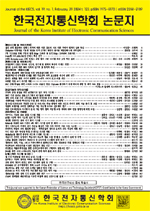DWT 기반 딥러닝 잡음소거기에서 웨이블릿 최적화
Optimizing Wavelet in Noise Canceler by Deep Learning Based on DWT
- 한국전자통신학회
- 한국전자통신학회 논문지
- 제19권 제1호
-
2024.02113 - 118 (6 pages)
-
DOI : 10.13067/JKIECS.2024.19.1.113
- 18

본 논문에서는 음향신호의 배경잡음을 소거하기 위한 시스템에서 최적의 wavelet을 제안한다. 이 시스템은 기존의 단구간 푸리에변환(STFT: Short Time Fourier Transform) 대신 이산 웨이블릿변환(DWT: Discrete Wavelet Transform)을 수행한 후 심층학습과정을 통하여 잡음소거 성능을 개선하였다. DWT는 다해상도 대역통과필터 기능을 하며 각 레벨에서 모 웨이블릿을 시간 이동시키고 크기를 스케일링한 여러 웨이블릿을 이용하여 변환 파라미터를 구한다. 여기서 음성을 분석하는데 가장 적합한 모(mother) 웨이블릿을 선정하기 위해 여러 웨이블릿에 대한 잡음소거 성능을 실험하였다. 본 연구에서 여러 웨이블릿에 대한 잡음소거시스템의 성능을 검증하기 위하여 Tensorflow와 Keras 라이브러리를 사용한 시뮬레이션 프로그램을 작성하고 가장 많이 사용되는 4개의 wavelet에 대해 모의실험을 수행하였다. 실험 결과, Haar 또는 Daubechies 웨이블릿을 사용하는 경우가 가장 우수한 잡음소거 성능을 나타냈으며 타 웨이블릿을 사용하는 경우보다 평균자승오차(MSE: Mean Square Error)가 크게 개선되는 것을 볼 수 있었다.
In this paper, we propose an optimal wavelet in a system for canceling background noise of acoustic signals. This system performed Discrete Wavelet Transform(DWT) instead of the existing Short Time Fourier Transform(STFT) and then improved noise cancellation performance through a deep learning process. DWT functions as a multi-resolution band-pass filter and obtains transformation parameters by time-shifting the parent wavelet at each level and using several wavelets whose sizes are scaled. Here, the noise cancellation performance of several wavelets was tested to select the most suitable mother wavelet for analyzing the speech. In this study, to verify the performance of the noise cancellation system for various wavelets, a simulation program using Tensorflow and Keras libraries was created and simulation experiments were performed for the four most commonly used wavelets. As a result of the experiment, the case of using Haar or Daubechies wavelets showed the best noise cancellation performance, and the mean square error(MSE) was significantly improved compared to the case of using other wavelets.
Ⅰ. 서 론
Ⅱ. 이산 웨이블릿 변환
Ⅲ. DWT 기반 잡음 소거시스템
Ⅳ. 웨이블릿의 성능 비교분석
Ⅴ. 결 론
References
(0)
(0)